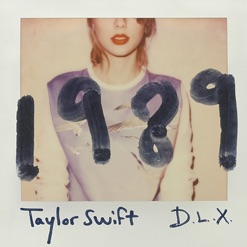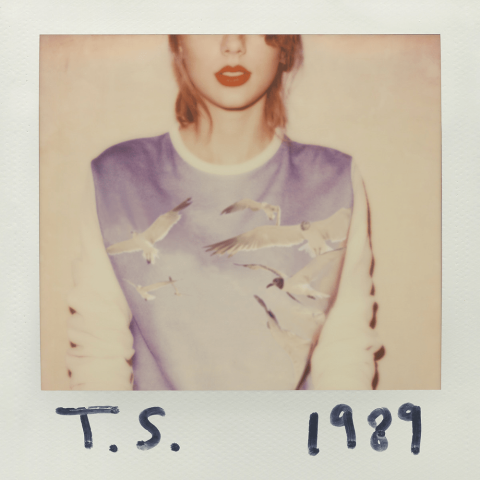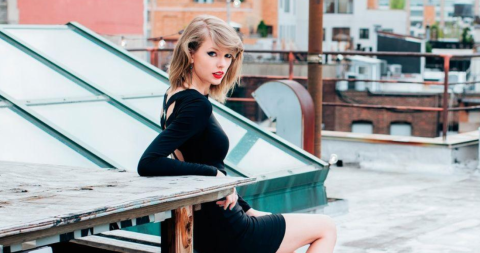


Taylor Swift does not do things by halves.
Her embrace of pop music was always inevitable, but it did take time. She often flirted with the genre - you can trace her penchant for an anthemic chorus all the way back to Teardrops On My Guitar - but seemed hesitant to fully commit, given that her first, initial bout of success had been experienced in the country genre, where lyricism and story-telling always takes precedence against hook and rhythm.
But when Taylor Swift did decide to make a pop album, she went all in. 1989 is big, bold and brash. It is, in many ways, the perfect pop album for the perfect pop star. Or at least, the image of the perfect pop star that Taylor would want to embody during its press cycle (even if Taylor herself would continue to play, twist and subvert this image on albums like reputation and folklore further down the line).
The genesis of 1989 is, by now, well-documented. Taylor was up for Album of the Year at the 2014 Grammy's with Red. She ended up losing the gong to Daft Punk's Random Access Memories, and not winning any of the categories she was nominated for. Red, at that point, had been a big breakthrough moment for Tay; it was the record where a lot of the critics sat up and started to appreciate what she was doing. But to Taylor, something clearly hadn't clicked.
Getting back to her hotel room that night, she speaks about the idea coming to her like some divine intervention. There it was, in a brilliant flash; Red was too scatter-shot sonically, it had used elements of country, arena-rock and pop without committing to any one lane (which is, admittedly, part of what makes Red such a good album, but who are we to argue with Taylor Swift?). Her next album would be different. It would be her first, official, fully pop record. It would be cohesive and sonically coherent. It would be called 1989, after the year of her birth, and be inspired by the music of that decade.
Basically, Taylor Swift wanted to be a pop star. So, being Taylor Swift, she naturally didn't just become a pop star. She became the biggest, and best, pop star in the world.

1989 ticks all the boxes Taylor wanted it to tick. It is definitely pop, although it's a bit of misdirection to say that it's an album fully indebted to 80s synth-pop (really, only Out of the Woods, This Love and New Romantics fit that brief), but it trips between several pop sub-genres with gleeful abandon. There's the icy minimalism of Blank Space (heavily inspired by Lorde's work on Pure Heroine), the sophisticated French disco of Style, the brassy, big-band maximalism of lead single Shake It Off and the alternative twist of closing track Clean.
But everything fits together neatly, mostly thanks to the fact that Taylor chose the perfect executive producer to help her shape 1989; Max Martin, the Swedish svengali who found an equally poignant muse in our Tay. Their work together on 1989 would be entirely definitive in both of their careers; you can hear Taylor twisting her biggest talent - her lyricism - into different forms to fit into Max's pop formula, and you can also hear Max's productions ramping up to support her vision. The drums crash harder. The choruses soar higher. As an added bonus, Max produced Taylor's vocals on every 1989 track (even the ones he didn't produce himself), so each song fit her like a glove.
Each Taylor Swift album has a definitive statement at its core, the concluding sentence to the thesis she writes with each body of work. Think of Getaway Car on reputation, All Too Well on Red and august on folklore. You could have your pick on which track performs this function for 1989, but the most obvious choice is Style. A darker twin sister to Max's work with Katy Perry on Teenage Dream, Style is an endlessly elegant pop track, perhaps the moment where Taylor and Max Martin's vision finally reached a perfect syncopation. It tells a classic story - good girl falls for bad boy - but allows itself to muddy the waters. They keep coming back to each other, even though they know they'll never work.
'I say "I heard, oh, you've been out and about with some other girl,''' Taylor sings. 'He says, "What you heard is true, but I, can't stop thinking about you." I said, "I've been there too a few times."'
It's a stunning plot twist from the woman who once wrote about being in a Romeo and Juliet-esque Love Story, who was convinced that love was a fairy tale. But Style takes a different view, love is dark and dangerous, swapping pretty lyricisms for the headlights of cars driving late and night, of tousled hair and white tees. This is imagery Taylor would take and run with on reputation (which in large parts abandons narrative for intense flashes of emotion and scenery), but it's never so potent as it is on Style, where it feels like a dangerous and unprecedented move.
Of course, we all know what happened when 1989 dropped. Bolstered by the success of Shake It Off - a song so confident that it could have never been anything else but 1989's lead single, the biggest flex of an artist realising she was finally too big to fail - 1989 arrived in 2014 like a comet from the sky. It was a juggernaut. And with the right timing and a little luck, Taylor finally crossed over. The critics she had enamoured with Speak Now and Red were now fully on-board, and she had successfully converted her earlier fans and her more passive newer ones to follow her on her pop journey.
1989 became Taylor Swift's first-ever Number 1 album in the UK. She now has 10, all achieved consecutively, and is still the only act this century to claim this feat. Madonna still holds the record for the female soloist with the most Number 1 albums, with twelve to her name.
According to Official Charts Company data, to date, 1989 has sold over 1.7 million chart units in the UK, including over a million pure sales based on physical purchases (754,000) and digital downloads (400,000) alone. Together, the 16 tracks that make up 1989's deluxe version have accumulated a mammoth 940 million streams and counting.
1989 was so successful - and it still holds up - because Taylor had a vision not just for the album, but where she saw pop music going. In a time which was overtaken with EDM club music, she resisted that pull. She brought it back to synths and 808s and bridges. She worked with the most successful pop producers at the time (Max Martin, Ryan Tedder) and anointed the man who would one day take their place (Jack Antonoff).
Taylor had always gladly marketed herself as something of an outsider in her music, just look at the You Belong With Me video. But that image began to naturally shift with 1989. Taylor was no longer the outsider. She was pop's main girl. Its Regina George, but with better intentions. This would, of course, come with consequences in the ensuing years, but at the time, her place at the top of pop's hierarchy wasn't challenged. It was accepted.

1989 was Taylor's first Imperial Phase, and for a while, it seemed like it would be her last. That she would never reach the heights - critically and commercially, at the same time - as she had on this album. But, Taylor Swift has never played by anyone's pre-determined rules. Technically, right now, in 2023, her second Imperial Phase is more impactful and successful than her first. Thanks to the quick releases of folklore, evermore and Midnights she shook off the shackles of Lover and with her far-reaching re-recordings of her first six albums and her career retrospective The Eras Tour, she's reached a place of public exposure and adoration that we haven't seen since Beatlemania took hold in the 1960s.
1989 (Taylor's Version) arrives this week with all of its classic tracks fully re-recorded and re-produced (it appears that 1989's main architect, Max Martin, sadly isn't involved in the process, as he was missing from Red (Taylor's Version), although his protege Shellback did get several production credits) and, even more excitingly, five previously unreleased tracks 'from the Vault'; Slut! (!), Id It Over Now?, Now We Don't Talk, Say Don't Go and Suburban Legends.
It will be fascinating to see the songs that didn't make the cut the first time around (Message In A Bottle from Red, the first song Taylor ever wrote with Max Martin and Shellback, certainly felt like the most obvious bridge to where she was going with 1989) but it will also be a time to look back and take stock. 1989 undeniably shifted Taylor's career into superstardom, and we can feel the reverberations of its release in the wider pop landscape. Every main pop girl wants their own 1989 era. It's become a catch-all term for the kind of dominance and media saturation most pop stars today can dream of.
After all, Taylor Swift doesn't do things by halves.
1989 (Taylor's Version) drops October 27 via EMI.


Join the conversation by joining the Official Charts community and dropping comment.
Already registered?
Log in
No account?
Register